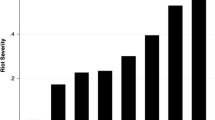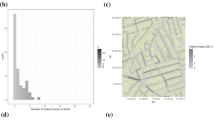Abstract
Despite a great deal of theoretical and empirical attention given to racial residential segregation and its influence on a number of social problems in the United States, few scholars have examined the role that this persistent form of racial inequality plays in shaping the magnitude of formal social control efforts. Our study examines this relationship by assessing the potential influence that the isolation of minorities may have on efforts to control crime in urban centers across the United States. Using a pooled time-series regression technique well suited for the analysis of aggregate, longitudinal data, we assess the potential influence of racial segregation on the size of municipal police departments in 170 U.S. cities between 1980 and 2010. After accounting for minority group size, economic threat, crime, and disorganization, we find that racial residential segregation has a significant non-linear effect on police force size. Cities with the most racially integrated populations have the smallest police presence but at very high levels of segregation, police strength levels off. This finding is consistent with expectations derived from the contact hypothesis. Under such conditions, majority group members appear to be less inclined to demand greater crime control measures such as increased police protection. Period interactions with residential segregation also suggest that this relationship has grown stronger in each decade since 1980. Overall, our study provides strong support for threat theories and the contact hypothesis but offers necessary refinements.

Similar content being viewed by others
References
Allport, G. W. (1954). The nature of prejudice. Boston, MA: Addison-Wesley.
Arvanites, T. M., & Asher, M. A. (1998). State and county incarceration rates: The direct and indirect effects of race and inequality. American Journal of Economics and Sociology, 57, 207–222.
Blalock, H. (1967). Towards a theory of minority group relations. New York: Capricorn Books.
Blau, P. R. (1977). A macrosociological theory of social structure. The American Journal of Sociology, 83, 26–54.
Blauner, R. (1972). Marxian theory and race relations. American Sociological Association Annual Meeting.
Bordua, D. J., & Haurek, E. W. (1971). The Police Budget’s Lot: Components of the increases in Local Police Expenditures. In Hahn, H. (Ed.), Police in Urban Society (pp. 57–70). Beverly Hills, CA: Sage Publications.
Carmichael, J. T. (2005). The determinants of jail use across large US cities: An assessment of racial, ethnic, and economic threat explanations. Social Science Research, 34(3), 538–548.
Chambliss, W. J. (1976). Functional and conflict theories of crime. In W. J. Chambliss & M. Mankoff (Eds.), Whose law? What order? (pp. 1–28). New York: John Wiley.
Chambliss, W. J., & Seidman, R. (1980). Law, order, and power. Reading: Addison-Wesley.
Chiricos, T. G., & Delone, M. A. (1992). Labor surplus and punishment: A review and assessment of theory and evidence. Social Problems, 39, 421–446.
Cohen, S., Barkan, S., & Halterman, W. (1991). Punitive attitudes toward criminals: Racial consensus or racial conflict? Social Problems, 38, 287–296.
Collins, R. (1975). Conflict sociology. Waltham, MA: Academic Press.
DeFina, R., & Hannon, L. (2009). Diversity, racial threat, and metropolitan housing segregation. Social Forces, 88(1).
Dyer, J., Vedlitz, A., & Worchel, S. (1989). The correlates of social distance among social and ethnic groups in Texas. Social Science Quarterly, 70, 607–616.
Ellison, C. G., & Powers, D. A. (1994). The Contact Hypothesis and Racial Attitudes Among Black Americans. Social Science Quarterly, 75, 385–400.
Garland, D. (1990). Punishment and modern society. Chicago: University of Chicago Press.
Greenberg D. F., & West, V. (2006). State prison populations and their growth, 1971–1991. Criminology, 39, 615–654.
Greene, W. H., (2012). Econometric analysis. 7th Edition. Upper Saddle River, NJ: Prentice Hall.
Gurr, T. R. (1979). On the history of violent crime in Europe and America. In H. D. Graham & T. R. Gurr (Eds.), Violence in America: Historical and comparative perspectives (pp. 544–596). Beverly Hills: Sage Publications.
Hahn, H. (1971). Police in Urban Society. Beverly Hills, CA: Sage Publications.
Holmes, M. D., Smith, B. W., Freng, A. B., & Munoz, E. A. (2008). Minority threat, crime control, and police resource allocation in the Southwestern United States. Crime and Delinquency, 54, 128–152.
Hum, T., & Zonta, M. (2000). Residential patterns of Asian Americans. In P. Ong (Ed.), The State of Asian Pacific America: Transforming race relations. Los Angeles: LEAP Asian Pacific American Public Policy Institute and UCLA Asian American Studies Center.
Jackson, P. I. (1989). Minority group threat, crime and policing. New York: Praeger.
Jackson, P. I., & Carroll, L. G. (1981). Race and the war on crime: the sociopolitical determinants of municipal police expenditures. American Sociological Review, 46, 290–305.
Jacobs, D. (1979). Inequality and police strength: conflict theory and coercive control in metropolitan areas. American Sociological Review, 44, 913–925.
Jacobs, D., & Carmichael, J. T. (2001). The politics of punishment across time and space: A pooled time series analysis of imprisonment rates. Social Forces, 80, 61–89.
Jacobs, D., & Helms, R. (1997). Testing coercive explanations for order: The determinants of law enforcement strength over time. Social Forces, 75, 1361–1392.
Jacobs, D., & Helms, R. (2001). Towards a political sociology of punishment: politics and changes in the incarcerated population. Social Science Quarterly, 30, 171–194.
Johnston, J., & DiNardo, J. (1997). Econometric methods. New York: McGraw Hill.
Kelly, M. (2000). Inequality and crime. The Review of Economics and Statistics, 82, 530–539.
Kent, S. L., & Jacobs, D. (2005). Minority threat and police strength from 1980 to 2000: A fixed-effects analysis of nonlinear and interactive effects in large cities. Criminology, 43, 731–760.
Krivo, L. J., Peterson, R. D., Rizzo, H., & Reynolds, J. (1998). Race, segregation, and the concentration of disadvantage: 1980–1990. Social Problems, 45, 61–80.
Land, K. C., McCall, P. L., & Cohen, L. E. (1990). Structural covariates of homicide rates: are there any invariances across time and social space? The American Journal of Sociology, 95, 922–963.
Lenski, G. (1966). Power and privilege. New York: Macmillan.
Liska, A. E., & Chamlin, M. B. (1984). Social structure and crime control among macrosocial units. American Journal of Sociology, 90, 383–395.
Liska, A. E., Lawrence, J. J., & Benson, M. (1981). Perspectives on the legal order. American Journal of Sociology, 87, 412–426.
Liska, A. E., Lawrence, J. J., & Sanchirico, A. (1982). Fear of crime as a social fact. Social Forces, 60, 760–771.
Loftin, C., & McDowall, D. (1982). The police, crime and economic theory. American Sociological Review, 47, 633–644.
Maguire, E. R. (2001). Research evidence on the factors influencing police strength in the United States. In C. S. Koper, E. R. Maguire, & G. E. Moore (Eds.), Hiring and retention issues in police agencies: Readings on the determinants of police strength, hiring and retention of officers and the federal cops program (pp. 7–25). A report to the National Institute of Justice. Retrieved from http://www.urban.org/pdfs/Hiring-and-Retention.pdf.
Massey, D. & Denton, N. (1987). Trends in the Residential Segregation of Blacks, Hispanics, and Asians: 1970-1980. American Sociological Review 52, 802–25.
Massey, D., & Denton, N. (1989). Hyper Segregation in U.S. Metropolitan Areas: Black and Hispanic Segregation along Five Dimensions. Demography, 26, 373–91.
McCarty, W. P., Ren, L., & Zhao, J. (2012). Determinants of police strength in large U.S. cities during the 1990s: A fixed-effects panel analysis. Crime and Delinquency, 58, 397–424.
McFarland, M., & Smith, C. A. (2011). Segregation, race, and infant well-being. Population Research Policy Review, 30, 467–493.
Messner, S., & South, S. (1986). Economic deprivation, opportunity structure, and robbery victimization: Intra and interracial patterns. Social Forces, 64, 975–991.
Messner, S. F., & Golden, R. M. (1992). Racial-inequality and racially disaggregated homicide rates: An assessment of alternative theoretical explanations. Criminology, 30, 421–447.
Myer, A. J., & Chamlin, M. B. (2011). Aggregation bias and the benign neglect hypothesis. Journal of Crime and Justice, 34(2), 124–138.
Nalla, M. K., Lynch, M. J., & Leiber, M. J. (1997). Determinants of police growth in Phoenix, 1950–1988. Justice Quarterly, 14, 115–142.
Oliver, & Mendelberg. (2000). Reconsidering the environmental determinants of white racial attitudes. American Journal of Political Science, 44(3), 574–589.
Ousey, G. C., & Lee, M. R. (2008). Racial disparity in formal social control: An investigation of alternative explanations of arrest rate inequality. Journal of Research in Crime and Delinquency, 45(3), 322–355.
Peterson, R., & Krivo, L. J. (1993). Racial segregation and black urban homicide. Social Forces, 71, 1001–1026.
Pratt, T. C., & Cullen, F. T. (2005). Assessing macro-level predictors of crime: a meta-analysis. Crime and Justice, 32, 373–450.
Quillian, L., & Pager, D. (2001). Black neighbors, higher crime? The role of racial stereotypes. The American Journal of Sociology, 107, 717–767.
Quinney, R. (1974). Critique of the legal order. Boston: Little, Brown.
Rubenstein, J. (1973). City police. New York: Farrar, Straus and Giroux.
Rugh, J. S., & Massey, D. S. (2010). Racial segregation and the American foreclosure crisis. American Sociological Review, 75(5), 629–651.
Rusche, G., & Kirchheimer, O. (1939). Punishment and social structure. New York: Russell and Russell.
Sever, B. (2001). The relationship between minority populations and police force strength: Expanding our knowledge. Police Quarterly, 4, 28–68.
Sharp, E. B. (2006). Policing Urban America: A new look at the politics of agency size. Social Science Quarterly, 87, 291–307.
Sigelman, L., & Welch, S. (1993). The contact hypothesis revisited: black-white interaction and positive racial attitudes. Social Forces, 73, 781–795.
South, S., Crowder, K., & Pais, J. (2011). Metropolitan structure and neighborhood attainment: Exploring intermetropolitan variation in racial residential segregation. Demography, 48(4), 1263–1292.
South, S. J., & Felson, R. B. (1990). The racial patterning of rape. Social Forces, 69, 71–93.
Spitzer, S. (1975). Toward a marxian theory of deviance. Social Problems, 22, 638–651.
Stucky, T. D. (2005). Local politics and police strength. Justice Quarterly, 22, 139–169.
Stults, B. J., & Baumer, E. P. (2007). Racial context and police force size: Evaluating the empirical validity of the minority threat perspective. The American Journal of Sociology, 113(2), 507–546.
Sutton, J. (2000). Imprisonment and social classification in five common-law democracies, 1955–1985. The American Journal of Sociology, 106, 350–386.
Tittle, C., & Curran, D. (1988). Contingencies for dispositional disparities in juvenile justice. Social Forces, 67, 23–58.
Turk, A. T. (1969). Criminality and the legal order. Chicago: Rand McNally.
Wacquant, L. (2001) Deadly symbiosis: When ghetto and prison meet and mesh. Punishment & Society, 3(1), 95–133.
Welch, S., Sigelman, L., Bledsoe, T., & Combs, M. (2001). Race and place: Race relations in an American city. New York: Cambridge University Press.
White, H. (1980). A heteroskedasticity-consistent covariance matrix estimator and a direct test for heteroskedasticity. Econometrica 48(4), 817–838.
Williams, R. M. Jr. (1964). Strangers Next Door: Ethnic Relations in American Communities. Engle-wood Cliffs, N.J.: Prentice-Hall.
Wilson, J. Q. (1971). Varieties of police behavior. New York: Atheneum.
Wilson, W. J. (1978). The declining significance of race: blacks and changing American Institutions. Chicago: University of Chicago Press.
Zhao, J., Ren, L., & Lovrich, N. (2012). Political culture vs. socioeconomic approaches to predicting police strength in U.S. police agencies: Results of a longitudinal study, 1993–2003. Crime & Delinquency, 58(2), 167–195.
Author information
Authors and Affiliations
Corresponding author
Additional information
Stephanie L. Kent and Jason T. Carmichael contributed equally to the paper.
Rights and permissions
About this article
Cite this article
Kent, S.L., Carmichael, J.T. Racial Residential Segregation and Social Control: A Panel Study of the Variation in Police Strength Across U.S Cities, 1980–2010. Am J Crim Just 39, 228–249 (2014). https://doi.org/10.1007/s12103-013-9212-8
Received:
Accepted:
Published:
Issue Date:
DOI: https://doi.org/10.1007/s12103-013-9212-8




